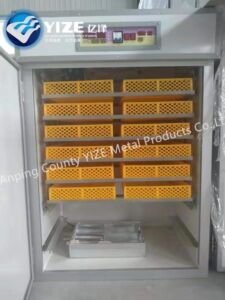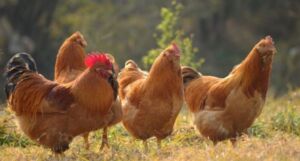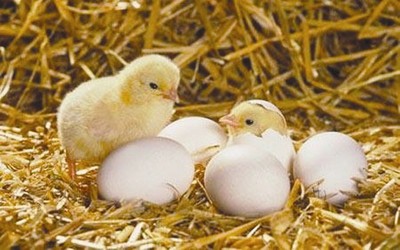
Chick hatching is divided into natural hatching and artificial hatching. The incubation period of chickens is about 21 days, 18 days for placing on the plate, 7 days for egg placement, generally affected by room temperature, early or delayed hatching may occur. Natural incubation, where the hen hatches the eggs, can save labor and provide suitable temperature and humidity, but it is not suitable for large-scale incubation of eggs. The appropriate temperature and humidity control can directly affect the hatching rate of eggs. Therefore, choosing appropriate hatching technology and artificially controlling the hatching environment can increase the hatching rate of breeding eggs
During the entire incubation period, chicken breeding eggs must be operated on and managed by human beings, but according to the characteristics of embryo development, there are two key periods, 1st embryo age to 7th embryo age and 18th embryo age to 21st embryo age. In the incubation operation, try to create as much as possible the incubation conditions suitable for the embryo development in these two periods, that is, grasp
The main contradiction between the improvement of hatchability and the quality of chicks is solved. Generally, attention is paid to heat preservation in the early stage and ventilation in the later stage.


Embryo age from 1 day to 7 days
In order to increase the incubation temperature and shorten the time to reach the appropriate incubation temperature as soon as possible, take the following measures:
1. Preheat the eggs before hatching, which will not only help the embryos to wake up and restore vitality, but also reduce the temperature drop in the incubator and shorten the healing time.
2. After incubating for 1 to 5 days, all air inlets of the incubator are closed.
3. When using formalin and potassium permanganate to disinfect the hatching eggs in the incubator, it should be carried out after the surface of the eggshell is condensed and dried, and the embryos of 24 hours to 96 hours of embryo age should be avoided.
Do not light the eggs before 4.5 days of embryonic age to avoid a sharp drop in the temperature of the incubator and egg surface. The whole batch of eggs should be taken after 5 days of embryonic age. In addition, broken eggs should be removed.
5. Increase the ambient temperature of the incubator.
6. Avoid prolonged power outages. In case of power failure, in addition to increasing the temperature of the incubator, you can also heat water in the water tray.
18-day embryo age ~ 21-day embryo age
The embryo age of chicken embryo from 18th to 19th day is the period of embryo transition from 06-06-30 membrane respiration to lung respiration. The oxygen demand increases sharply, the embryo self-temperature is very high, and with the peck and hatching, the inside of the shell Pathogenic microorganisms spread rapidly in the incubator, and adequate ventilation should be used during this period. To solve the problem of oxygen supply and heat dissipation, the following measures should be taken.
1. Avoid transferring the plate to the hatching plate at the embryonic age of 18 days. The plate can be moved in advance at the embryonic age of 17 days or postponed to the embryonic age of 19 days.
2. Increase the humidity while pecking the shells and hatching while lowering the temperature. On the one hand, it is to prevent the moisture in the egg from evaporating faster when the eggshell is broken, which is unfavorable for breaking the shell; on the other hand, it can prevent the chicks from dehydration, especially when the chick lasts for a long time, increasing the humidity is more important. While increasing the humidity should reduce the
The hatching temperature of the brooder should avoid high temperature and high humidity at the same time. When embryo age from 19th to 21st day, the hatcher temperature should not exceed 37℃~37.5℃. During the hatching period, the relative humidity is increased to about 70%~75%.
3. Pay attention to ventilation and increase the amount of ventilation if necessary.
4. Ensure the normal power supply. Even if there is a short-term power failure during this period, the impact on the incubation effect is not small. The emergency measures in case of a power failure are: open the door of the machine, turn the tray up and down, and measure the egg temperature with a thermometer. At this time, the temperature displayed by the door thermometer can never represent the temperature in the hatcher.
5. Choosing the time for picking chicks, usually when 60%~70% of the chicks are out of the shell and the fluff is dry, the chicks are picked for the first time. Prior to this, only empty eggshells were picked. After hatching, move the unhatched embryonated eggs to the top of the hatcher in order to hatch. Finally, pick the chicks once and sweep the trays
.

6. Shading of the observation window. The chicks are phototaxis, and the chicks that have come out of the shell will be crowded to the front of the hatching tray. It is unfavorable for other embryo eggs to emerge from the shell. Therefore, the observation window should be shaded to keep the chicks quiet.
7. Prevent the chicks from dehydration. Chick dehydration seriously affects the survival rate, and it is irreversible. Therefore, the chicks should not be placed in the 06-06-30 container and in the chick processing room for a long time. The chicks cannot be released at the same time. Even if they are relatively tidy, the earliest and the most There is also a difference of about 32 hours in the time of late emergence, plus a series of tasks after hatching, such as grading, injection, and identification, and the time is even longer.
Therefore, it may have been nearly 48 hours from the time the chicks are hatched to the hands of the breeder, and it may have been nearly 48 hours for the hulls, so they should be sent to the brooding room or the user in time.


